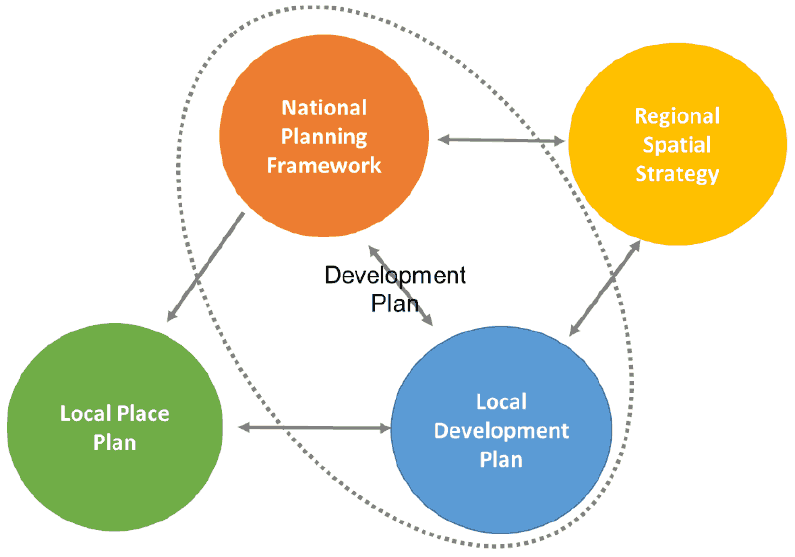Local development planning - regulations and guidance consultation: part C - local development planning - draft guidance
Part C of the local development planning - regulations and guidance consultation sets out: (1) the overall aims and expectations for new style LDPs; (2) the process of how to achieve a new style plans; (3) and detailed thematic guidance on how new style plans are to implement policies in NPF4.
Section 1 – Aims of New Style Plans
4. This section sets out the overall aims for plans prepared under the Town and Country Planning (Scotland) Act 1997, as amended by the Planning (Scotland) Act 2019.
Development Plans
5. Development planning is required by law to manage the development and use of land in the long term public interest. It does this by setting out how our places will change into the future, including where development should and shouldn’t happen. Development plans consider where our new homes and workplaces will be built, how services and facilities will be provided, such as education and travel, and identify the places we value and should therefore protect. Plans have a role in co-ordinating and aligning many different sectors and interests to achieve the desired change for places and communities.
6. The planning system in Scotland is plan-led. The law says that decisions on planning applications are to be made in accordance with the Development Plan, unless material considerations indicate otherwise.
7. The statutory Development Plan for any place in Scotland consists of the National Planning Framework (NPF), which covers all of the country, and the Local Development Plan (LDP) for the planning authority area where the place is.

8. The Development Plan will be informed by plans at other scales: Regional Spatial Strategies (RSS) that address strategic development, often across local authority boundaries; and Local Place Plans (LPPs), community-led plans that focus on places within local authorities’ areas, which may include particular neighbourhoods.
Purpose of Planning
9. The purpose of planning is to manage the development and use of land in the long term public interest. This includes contributing to sustainable development, and the achievement of the National Performance Framework National Outcomes. There are 11 national outcomes that describe the kind of Scotland we want to see. Draft NPF4 Policy 1 looks to address this with a plan-led approach to sustainable development.
10. The cross-cutting nature of development planning means it contributes to all outcomes. Plans at all scales have a role in co-ordinating and aligning many different sectors and interests to achieve the desired change for places and communities.

Our Purpose
To focus on creating a more successful country with opportunities for all of Scotland to flourish through increased wellbeing, and sustainable and inclusive economic growth
Our Values
We are a society which treats all our people with kindness, dignity and compassion, respects the rule of law, and acts in an open and transparent way
National Outcomes
- Children and Young People: We grow up loved, safe and respected so that we realise our full potential
- Communities: We live in communities that are inclusive, empowered, resilient and safe
- Culture: We are creative and our vibrant and diverse cultures are expressed and enjoyed widely
- Economy: We have a globally competitive, entrepreneurial, inclusive and sustainable economy
- Education: We are well educated, skilled and able to contribute to society
- Environment: We value, enjoy, protect and enhance our environment
- Fair Work and Business:We have thriving and innovative businesses, with quality jobs and fair work for everyone
- Health: We are healthy and active
- Human Rights: We respect, protect and fulfil human rights and live free from discrimination
- International: We are open, connected and make a positive contribution internationally
- Poverty: We tackle poverty by sharing opportunities, wealth and power more equally
Plans for the Future
11. It is a legal requirement for planning authorities to prepare an LDP. They should consider the ambitions and outcomes for an area, looking 20 years ahead. Plans should be developed through collaboration and based on robust evidence so that they are deliverable. They should be place-based, with the inclusion of a clear Spatial Strategy reflected more in a collection of maps, site briefs and masterplans than in written text and policy. Plans should be relevant and accessible to the people with an interest in that place. They should be prepared in a different way, look different and be used differently to before.
Delivery Focused
12. LDPs should be a toolkit to support delivery of development that meets people’s needs and aspirations of a place and the long term public interest. To be deliverable, a plan must be clear about what is sustainable, desirable and achievable. The LDP should support decisions to invest in a place, identifying priorities and making strong links between these and the Delivery Programme.
13. To achieve a delivery focussed system, it is crucial for it to run as a key theme through each aspect of plan preparation and implementation. LDPs should also be informed by, and become well embedded in, a wider context of local, regional and national planning activity, and particularly implementation.
14. Embedding an Infrastructure First approach is key to plans that deliver on outcomes. This means putting infrastructure considerations at the heart of spatial planning decisions to ensure that Development Plans are deliverable and to encourage longer term strategic planning. An Infrastructure First approach to development planning means that infrastructure considerations should be an integral part of the plan preparation process. Each stage has a role to play. Plans need to be based on an understanding of infrastructure requirements and investment needs early on to support site selection and then delivery, so that ambitions are realised.
15. The ongoing digital transformation of planning aims to support a planning system that is more inclusive and efficient as part of this.
Place-Based
16. LDPs should tell a clear and compelling story about the future of places. They should implement national policies in the NPF to show what they mean for change and development in a particular place. There isn’t one way to tell the story of a place, and different tools – including graphic and digital approaches - will work better in different places. There should however be universal focus on clarity, succinctness and accessibility for everyone who will use the plan. There is no single example of a plan that can be held up as ‘the perfect plan’. Annex A highlights different approaches to presentation and graphic communication. This is intended to provide ideas and prompt thinking for authorities exploring how to present new place-based LDPs.
17. The Place Principle promotes a joined-up and collaborative approach to decisions about a place’s assets and services to overcome organisational and sectoral boundaries. Development planning has a leadership role to play in putting this approach into practice. By working with others across the public, private, third and community sectors, development planning can help to make sure that development is deliverable and able to be implemented to meet the needs and aspirations of a place.
18. Local Outcomes Improvement Plans (LOIPs) must be taken into account in preparing LDPs. They are significant because they aim to meet the diverse aspirations and challenges of their places. The 2019 Act removed the requirement for an LDP to provide a vision statement. This was to avoid creating any potential conflict or confusion with a separate vision for an area, in the expectation that the plan will contribute to the priority outcomes set out in the LOIP. Plans should explain how this relates to development and land use to ensure the alignment is strong.
19. A focus on place also provides a route for better public engagement with development planning. People are more likely to take an interest in the LDP if it is clearly relevant to the places they live, work and spend their time.
People Centred
20. The preparation of an LDP should be collaborative to best meet the needs and aspirations of the different people who have an interest in a place and should be prepared with the involvement of local people. At a local level, aspirations of communities of either place or interest are not neatly segmented. Identifying and understanding the differing needs and aspirations of all people in society will be key to the delivery of an effective LDP as part of a place-based approach that also supports health and wellbeing. Decision-makers, communities and developers should have a clear understanding of such needs.
21. Whilst planning authorities have a duty to prepare an LDP, to achieve the intended outcomes for people, a wide range of stakeholders will need to play a role. Putting the Place Principle into practice and delivering on LOIPs involves a wide range of public, private, community and third sector people and organisations, who all have a stake in the future of our places from the national to the neighbourhood scale. This is where development planning has a coordinating role between a wide range of interests including, but not limited to, those listed below. Bringing different interests together to collaborate is a useful way to exchange experiences and perspectives, and can help break down barriers.
- Housing
- Transport
- Natural environment
- Economic development
- Health
- Energy
- Education
- Community wellbeing
- Community governance
- Regional governance
- National government
22. Local Place Plans (LPPs) have an important role to play in voicing the aspirations of local people. Where they have been prepared, the community’s proposals are able to be incorporated into the LDP. This will help LDPs reflect their communities’ place-based aspirations. Regulations on LPPs have been laid in the Scottish Parliament and are due to come into force in January 2022.
23. Planning authorities should ensure that appropriate and proportionate steps are taken to engage with communities and the public at large during the preparation of the LDP. Authorities’ plans for engagement should ensure that collaborative, meaningful and proportionate steps will be taken to engage people. They should take into account who may be directly, or indirectly, impacted by proposals, providing opportunities for a diverse range of people to express their views.
24. Innovative approaches to engagement, for example community-led design or the Place Standard Tool should be used to stimulate early engagement and inform the Evidence Report. Where needed, mediation initiatives tailored to the unique circumstances, can also be used. Further detail on effective community engagement will be included in separate guidance.
25. There is an opportunity for LDPs to address community wealth building priorities by reflecting a people-centred approach to local economic development, addressing economic disadvantage and inequality, and providing added social value.
Contact
Email: LDPRegsandGuidance@gov.scot
There is a problem
Thanks for your feedback